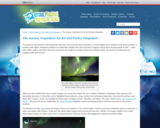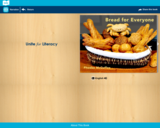
Artcyclopedia describes what symbolism is along with a list of symbolist artists. Click on an artist to find more information on them.
- Subject:
- Arts
- Material Type:
- Reading
- Provider:
- Artcyclopedia
- Date Added:
- 10/03/2023

Artcyclopedia describes what symbolism is along with a list of symbolist artists. Click on an artist to find more information on them.
![ArtsNow Learning: Exploring Adjectives Through Art and Creative Writing [PDF]](https://openspace.infohio.org/static/newdesign/images/materials/default-thumbnail-index.png)
In this lesson, students will use adjectives to describe artwork and to develop descriptive language in creating interesting and unique stories.

This article discusses how to use murals as an interdisciplinary, cooperative activity to blend science, art, and math concepts.

Novel representations and diverse perspectives can reveal new insights into complex systems, and can support rich understandings of the world. In this activity, students will identify and analyze the choices artists and scientists make when creating representations of living or non-living natural objects. This process will help students recognize the potential and place for their own articulation of how the world works. After drawing from nature, students will reflect on the process of representing information, then compare their drawings with that of a 16th-century artist. Students will consider what is included and what is excluded, and hypothesize about larger contexts and systems.

This article lists seven art techniques and four poetry types that can be used to depict and describe the aurora.

Children and adults enjoy participating in Lois Ehlert's colorful books. She discusses her work in this video interview with Reading Rockets. Also included at the site are biographical notes, a transcript of the interview and a list of some of her books.

Follow this link to the British Film Institute's glossary of film and television terms.

Visit an example-rich exploration of poster art and learn how famous faces have been used to convey meanings and messages across the decades. An excellent resource for discovering how art can be a window into a particular time, Ballyhoo! looks at images from a range of periods in U.S. history, including turn-of-the century America (ca. 1890), World War I, World War II, and the 1960s. An effective device, also, for learning about celebrity culture and the tried-and-true advertising ruse of celebrity endorsement.

This is a fun idea to display your students' book reports, and encourage reading at the same time! In this online lesson, children use special markers to actually draw their book report on the windows of the library or classroom. Also provides resources and adaptations. (To access this lesson plan, you must register with Crayola.com. Registration is free and takes only a few moments to complete.)

This lesson plan incorporates many subjects! Students create a flow chart after studying the "Evolution," of computers. Also provides adaptations and references to use. (To access this lesson plan, you must register with Crayola.com. Registration is free and takes only a few moments to complete.)

This site is a lesson plan that incorporates language arts, social studies, science, and art. After studying islands, and how they're formed, students create their own models using clay. Also provides resources and adaptations. (To access this lesson plan, you must register with Crayola.com. Registration is free and takes only a few moments to complete.)

This lesson plan incorporates art into a social studies or language arts class. Students create their own pictures, using the work of Harlem Renaissance artists as inspiration. Also provides resources and adaptations to try with this activity. (To access this lesson plan, you must register with Crayola.com. Registration is free and takes only a few moments to complete.)

This art history video discussion examines Francois Boucher's "Madame de Pompadour", oil on canvas, 1750 (extention of canvas and additional painting likely added by Boucher later, Fogg Museum.
Khan Academy learning modules include a Community space where users can ask questions and seek help from community members. Educators should consult with their Technology administrators to determine the use of Khan Academy learning modules in their classroom. Please review materials from external sites before sharing with students.

Learn about the different kinds of breads people eat around the world. Includes audio narration.

This long-term installation of Assyrian Reliefs is on view at the Brooklyn Museum. This page featueres pieces from the exhibition in addition to a description of both the exhibit and the work.

In this activity, you will build a bird feeder to attract birds, so you can study them.

Comprehensive information from the "Occupational Outlook Handbook" on artists and related workers, including discussions of the nature of the work, working conditions, training and qualifications, job outlook, earnings, sources of additional information, and related job categories.

This resource provides information about counseling careers. Also includes duties, training, salaries, work situations, and job outlook.

Learn about jobs in the field of designing, producing, exhibiting, performing, writing, and publishing.

This site provides a review of the book "The Castle in the Attic" by Elizabeth Winthrop. It also features ideas for activities and a list of related books.